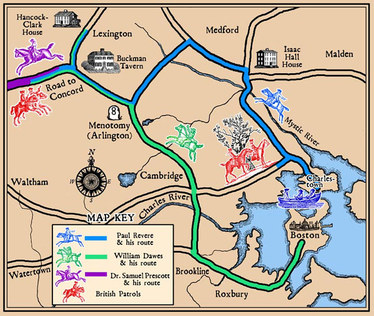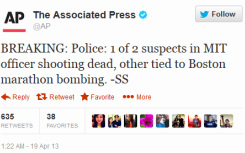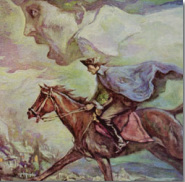The first time: The night of April 18th-19th, 1775
The second: The night of April 18th-19th, 2013.
Yesterday, it was due to a manhunt for the “Boston Marathon bombers”. Everything was “locked down“, a euphemism for martial law. (The euphemism is arguably scarier than the term it replaces, in this case). In 1775, it was amidst a wild political climate which saw Paul Revere ride through towns of Massachusetts shouting “the British are coming!” (forevermore to be learned-about by American elementary school students). Fighting followed.

One of the riders passed right through Cambridge.
Cambridge, it seems, was the place of residence of the “Boston bombers”. On April 19th, 2013, one was killed, and one captured, in adjacent “Watertown”.
Actually, there is a pretty amazing synchronicity:
- Revere was captured about 1 AM on April 19, 1775.
- The older Boston bomber, Tamerlan Tsarnaev, was also located by authorities at about 1 AM on April 19th (of 2013). (Tsarnaev was killed, Revere was not).

at about 1 AM EDT, April 19, 2013 /
238 years to the day and hour
after Paul Revere was captured
A Korean I spoke with on the matter pointed out that it was just three dead. (Three “civilians” and, later, one dead policeman). Bad, yes, but hardly necessitating a mass panic. The radio correspondents I was listening to were in a total daze: They said things like “we’ve never seen anything like this!” All regular programming was cut for round-the-clock coverage. Everything was closed. Millions were under martial-law: One million people within a certain radius were ordered indoors under threat of force (true martial-law), and millions more in Greater Boston were intimidated into staying off the street (defacto martial-law) too. Photos of deserted streets in Boston emerged. An entire city, empty. This was astonishing, to me.
Was this level of hysteria an overreaction? I think so, but it is also understandable: This kind of drama builds esprit-de-corps by giving people a shared and memorable experience. That is highly important, and something lacking in the USA in recent….decades, it seems to me.


The Boston Marathon: Aftermath
Two runners from Washington, D.C., shared their stories with The Washington Post (4-21-13) after last Monday’s 117th Boston marathon tragedy.
Miriam Becker-Cohen: “Saying that a marathon is the ultimate event of community spirit is an understatement. The support and admiration that pour out from the spectators and the camaraderie among the runners are indescribable.” Although she was in physical discomfort from leg cramps and felt like slowing her pace, she attributes the cheers and encouragement from the fans along the 26.2 mile route with her finishing the race soon BEFORE the bombs exploded—and witnessing the courage of the onlookers in helping when disaster struck.
David Park, who was 0.2 miles from the finish line when the bombs exploded and therefore was prevented from finishing the race, calls this event “a tragic and senseless end to an otherwise exuberant day.” He saw first hand “the spirit of this great city soar” as people reached out to help those in need. His memory of the marathon “is not of death and destruction but rather of the immense power of the human spirit and the generosity of the human heart.”
When some people think that because only three people lost their lives at the marathon, that this was not so big a tragedy after all, many millions would strongly disagree. The Boston Marathon is an international symbol of a city’s pride. This is a tragic first in its 117-year history and it will change lives in this country and abroad. Two young women and an eight-year-old boy with promising futures did not survive the blasts (http://www.cnn.com/2013/04/16/us/boston-marathon-victims-profiles/index.html?iref=allsearch). One of the women was from China and the other two victims were from Massachusetts. Things will never be the same for their families and friends—and for the more than 170 injured in the event and their families, the runners, the emergency workers, and the onlookers near and far. The feeling of joy, exuberance, and security, at this annual event was shattered. Hundreds of police and emergency workers attended the marathon, but with the sprawling route of the race it was not possible to prevent this tragedy.
Some of the more than 170 injured are still in critical condition five days after the bombing. Thirteen hospitals have been treating the wounded. The shrapnel (BB’s nails, and other metal debris) from the bombs tore through and embedded in muscles and bones, severing some limbs. A number of the injured required leg amputations; these patients face long and difficult rehabilitation, physical therapy, and the challenges of a life without limbs. Other injuries included punctured eardrums, third degree burns, great blood loss (thanks to tourniquet applications, more lives were not lost), broken bones, head traumas, cuts from falling glass, etc.
The finish line of the marathon, with the deafening explosions and their resulting air blasts and quaking buildings, the smoke, fires, shattered buildings, scattered debris, and blood soaked streets, seemed more like a war zone. Then, the spirit of the people soared and they reached out—and they continue to do so in support of those who died and were injured in this act of terror. Boston residents —and people everywhere in the U.S.—realized that this could happen anywhere and that life will no longer be the same.